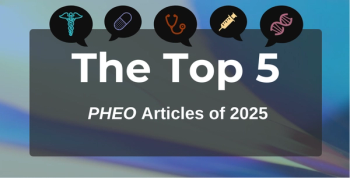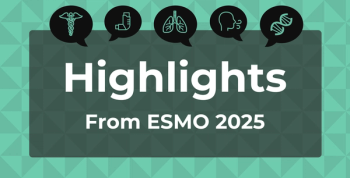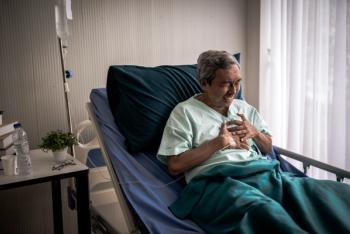
Combo Treatment Bests Cemiplimab Monotherapy, Phase 2 Data Show
Study results presented during the virtual European Society for Medical Oncology meeting demonstrated the superiority of cemiplimab (Libtayo) plus ipilimumab vs cemiplimab monotherapy for non–small cell lung cancer.
EMPOWER-Lung 4 data presented during this year’s virtual European Society for Medical Oncology (ESMO) meeting demonstrate the superiority of cemiplimab (Libtayo) plus ipilimumab vs cemiplimab monotherapy in the second-line setting for advanced squamous or nonsquamous non–small cell
As a checkpoint inhibitor, the monoclonal antibody cemiplimab has high affinity for programmed cell death 1 (PD-1). In the setting of
"The Libtayo clinical development program, as monotherapy or in combination with either conventional or novel therapies, focuses on the real-world challenges of patients confronting difficult-to-treat or rare cancers," Peter Adamson, MD, global development head, Oncology and Pediatric Innovation, at Sanofi,
Sanofi and Regeneron are collaborating to develop Libtayo.
In the phase 2, open-label study, 27 patients were randomized 1:1:1 into 3 arms:
- Arm A (n = 8): monotherapy treatment with 350-mg, or standard-dose, intravenous (IV) cemiplimab every 3 weeks (Q3W)
- Arm B (n = 11): combination treatment with 350-mg IV cemiplimab plus 50-mg IV ipilimumab every 6 weeks for up to 4 doses
- Arm C (n = 8): monotherapy treatment with 1050-mg, or high-dose, IV cemiplimab Q3W, up to 108 weeks or disease progression
All patients had Eastern Cooperative Oncology Group performance status of 0 or 1, were former smokers, and had stage IV disease. Most (71.4%) were male, and more than half (57.1%) had PD-1 < 1%. One died following randomization. Data cut-off was August 28, 2019.
Patients in Arm C were the oldest, with a mean (SD) age of 71.0 (46-80) years and those in Arm A, the youngest at 64.5 (49-74) years. All were also stratified by histology (squamous, nonsquamous) and PD-L1 expression (< 1%, 1%-49%, ≥ 50%). The primary measure was objective response rate (ORR) in each of the arms, and secondary objectives were ORR irrespective of PD-L1 status, safety and tolerability, and overall (OS) and progression-free survival (PFS) among patients with PD-L1 expression less than 50%.
Overall, the results demonstrate the effectiveness of the cemiplimab/ipilimumab combination treatment over both doses of cemiplimab-alone treatment:
- Arm B (the combination-treatment arm), which had the longest median duration of treatment exposure at 17.9 weeks (vs 10.8 weeks in both Arms A and C), also had the highest ORR: 45.5% (95% CI, 16.7%-76.6%).
- Arm C (high-dose cemiplimab monotherapy) had just an 11% ORR (95% CI, 0.3%-48.2%)
- Arm A (standard-dose cemiplimab monotherapy) had a 0% ORR (95% CI, 0.0%-36.9%)
- Patients with PD-L1 expression < 1% had a higher ORR in Arm B vs Arm C: 36.4% vs 11.1%
- Patients with PD-L1 expression of 1% to 49% had a higher ORR in Arm B vs Arm C: 9.1% vs 0%
- Combination treatment led to higher antitumor activity and more durable responses vs both doses of cemiplimab monotherapy
Additional analyses revealed a median duration of response (DOR) was not reached among patients achieving a complete response (CR) or partial response (PR) in Arms B and C. However, there was an observed DOR in both: 2+ to 6.9+ months in Arm B compared with 4.8+ months in Arm C. Arm A had no CRs or PRs.
The occurrence of any-grade treatment-emergent adverse events (AEs) was close to equal in the 3 arms:
- Arm A: 37.5% (decreased appetite, constipation)
- Arm B: 36.4% (hypothyroidism, pneumonia)
- Arm C: 37.5% (decreased appetite)
Five patients also experienced grade ≥ 3 immune-related AEs:
- Arm A: decreased appetite (n = 1)
- Arm B: hypothyroidism (n = 1), increased Gamma-glutamyltransferase (n = 1), increased blood alkaline phosphatase and myalgia (n = 1)
- Arm C: cerebrovascular accident (n = 1)
“This phase 2 study demonstrated that in patients with advanced squamous or non-squamous NSCLC and < 50% PD-L1 expression, second-line combination treatment with cemiplimab 350 mg plus ipilimumab 50 mg exhibited numerically higher anti-tumour activity than cemiplimab monotherapy (350 or 1050 mg),” the authors concluded. “No new safety concerns were identified compared with previous analyses of cemiplimab.”
Reference
Shim BY, Carpeño J de C, Chiu C-H, et al. EMPOER-Lung 4: a phase 2, randomized, open-label study of standard- or high-dose cemiplimab alone and standard-dose cemiplimab plus ipilumumab as second-line treatment for advanced non-small cell lung cancer (NSCLC). Presented at: ESMO Virtual 2020 Congress; September 19-21, 2020. Poster 1269P. https://esmo2020-distribution.esmo.org/from.storage?file=UqnETC1GOdEqmZaDzdfDi64azd%2bjEoNoA8WE3YSUZMc%3d
Newsletter
Stay ahead of policy, cost, and value—subscribe to AJMC for expert insights at the intersection of clinical care and health economics.







































